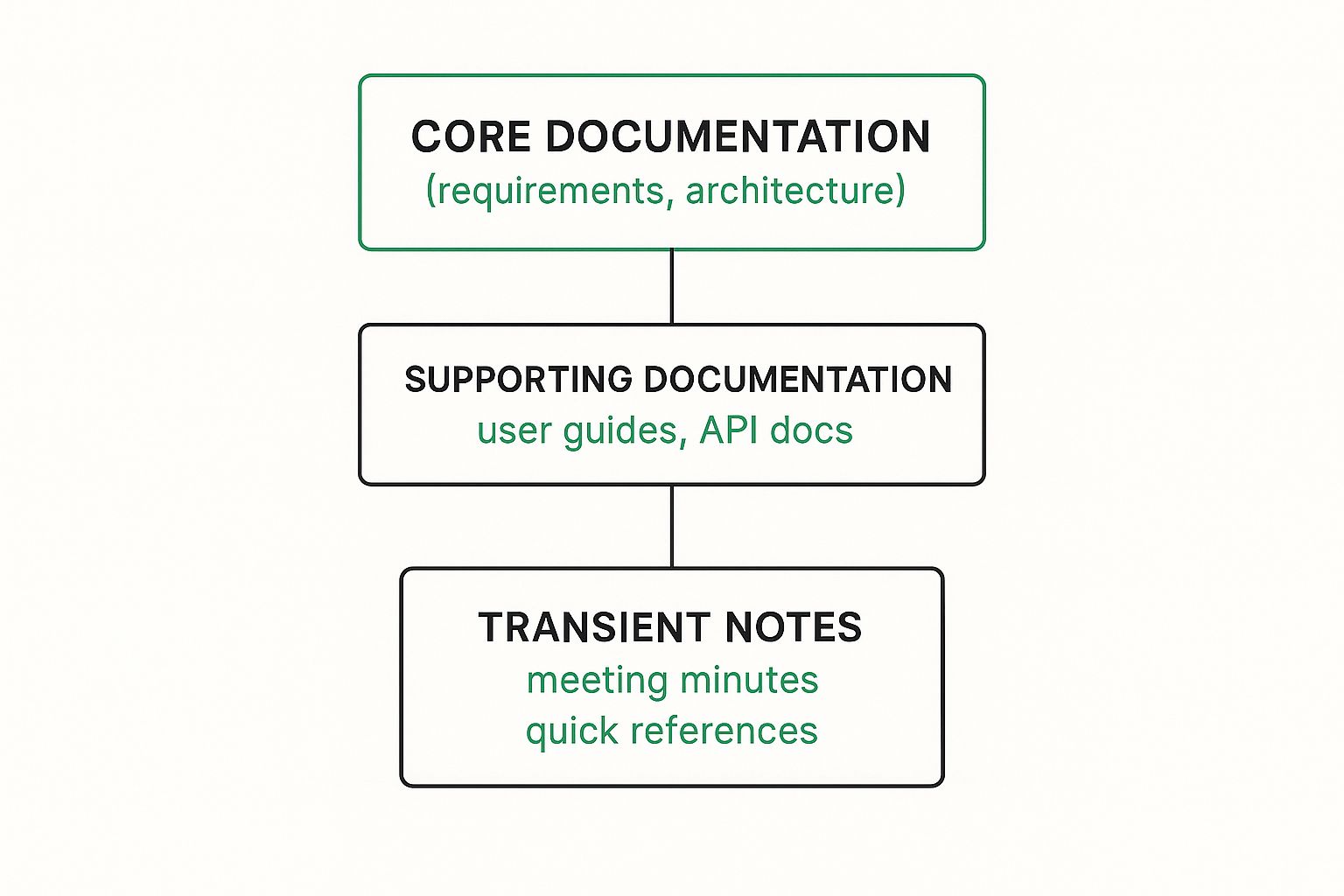Transform your approach to documentation in Agile. Learn proven principles, best practices, and how to use AI tools for a streamlined, effective workflow.
When people talk about documentation in Agile, they’re really talking about a mindset shift. It’s about creating just enough information, at precisely the right time, to help a team build software that actually works. This means trading in those massive, upfront manuals for lightweight, living artifacts like user stories and release notes that grow and change right alongside the project.
The whole point is to value collaboration and working software over static, exhaustive documents that are outdated the moment they’re printed.
One of the biggest myths I hear is that “Agile” means “no documentation.” That’s just not true. This idea comes from a misreading of a core value in the Agile Manifesto: “Working software over comprehensive documentation.” But here’s the thing: “over” doesn’t mean “instead of.”
The real key is to stop seeing documentation as a bureaucratic chore you have to check off a list. In an Agile world, it’s a dynamic, valuable tool that actively supports the development process.
Think of it this way: instead of a thick, printed instruction manual for a product you haven’t even built yet, you have a collaborative digital whiteboard. It’s a living guide that the team uses sprint by sprint. This approach ensures every single piece of documentation serves a clear, immediate purpose.
Traditional documentation is a snapshot in time. It’s created before the real work begins, which means it’s almost immediately out of date. Effective Agile documentation is the complete opposite—it’s a living resource that’s built to adapt.
This shift is a game-changer for a few reasons:
With Agile adoption now almost universal—something like 94% of organizations are practicing it—the need for better, smarter documentation has never been greater. This is especially true as more teams go remote, where clear and current documentation is critical. Understanding the best strategies for Distributed Agile Teams is more important than ever. You can dig deeper into these trends in the 16th State of Agile report.
At the end of the day, smart documentation fuels agility instead of slowing it down. By embracing a “just enough, just-in-time” philosophy, teams stay aligned, clear up confusion, and build better products, faster. Tools like DocuWriter.ai are designed specifically for this modern workflow, helping automate the creation of essential, high-quality documentation so your team can focus on what really matters.

To really get the hang of documentation in an Agile world, you have to stop thinking about rigid rules and start focusing on why you’re writing anything down in the first place.
Think of it like this: traditional documentation is a static, printed road map. It’s incredibly detailed and created entirely upfront, but the moment a road closes or a better route appears, it’s already out of date. Agile documentation, on the other hand, is like a live GPS.
A GPS doesn’t overwhelm you with every possible road in the country. It gives you just enough information, at exactly the right time, to make your next turn. It updates in real-time based on traffic and conditions, rerouting you as needed. That’s the heart of effective Agile documentation—it’s alive, interactive, and always relevant to the journey you’re on right now.
The first principle is an almost obsessive focus on customer value. Every single document you create should serve a clear purpose that helps the team deliver a better product. If it doesn’t add value, it’s waste. Plain and simple. This requires a cultural shift where the team is constantly asking, “Will this help us build the right thing?”
This mindset naturally leads to embracing change. An Agile team doesn’t see a shift in requirements as a planning failure; they see it as an opportunity to get closer to what the customer actually wants. Their documentation is built from the ground up to accommodate these pivots without causing a massive cascade of rework.
Agile documents are intentionally lightweight. They start small and evolve alongside the project, preventing the team from sinking a ton of time into comprehensive specs that are guaranteed to change.
This approach only works with deep collaboration. Documentation isn’t a task handed off to one person; it’s a shared responsibility baked into the team’s workflow. When everyone contributes, the documents become a living source of truth that reflects the team’s collective brainpower.
Of course, finding that sweet spot between enough detail and too much brevity is a constant challenge. It’s a balance that’s become critical, especially since 91% of organizations now view Agile as a strategic priority. This massive adoption is pushing the need for lighter documentation that actually supports how teams work today. In fact, European organizations, with 70% demonstrating high Agile maturity, have proven that effective, lean documentation is a cornerstone of their success. You can dig into more data on the global state of agile practices on Parabol.co.
Techniques like “docs-as-code,” where documentation is managed with the same version control tools as source code, are gaining a lot of traction for this very reason. It helps automate updates and keeps everything in sync.
By adopting these principles, teams can turn documentation from a bottleneck into an accelerator. And when you need to make that process even faster, tools like DocuWriter.ai can automate the heavy lifting, creating clear, concise, and developer-friendly docs so your team can stay focused on what they do best: building great software.
High-performing Agile teams have a secret: they don’t create less documentation; they create the right documentation. Forget those massive, upfront specification documents. Instead, think of a collection of living, breathing artifacts that guide development without bogging everyone down in bureaucracy.
The best way to get your head around this is to group the documents by what they’re trying to accomplish.

As you can see, some documents are foundational—they stick around for the long haul. Others are more temporary, serving a specific purpose for a short time before they’re archived or simply tossed aside.
This first group is all about the “what” and the “why.” These are the core documents that capture requirements and make sure the team is building something people will actually use and love.
While product docs define the destination, process docs map out the journey. They provide the structure and alignment needed to get through each development cycle without chaos.
Key examples include:
This kind of documentation isn’t just about record-keeping; it’s about being able to adapt. In Scrum, which is used by 87% of Agile teams, artifacts like the Product and Sprint Backlogs are non-negotiable for effective planning. And in the software world, where Agile adoption hits around 86%, good documentation is what makes knowledge sharing and onboarding new team members a smooth process.
Last but not least, technical documentation explains the “how.” It’s written by the development team, for the development team, ensuring the system is easy to understand, maintain, and scale down the road.
This includes things like:
To give you a clearer picture, here’s a quick breakdown of common Agile documents and their roles.
This table summarizes some of the key documents, who they’re for, and how often they should be touched.
Ultimately, these documents work together as a cohesive system that supports the development process instead of slowing it down. For teams looking to streamline this, tools like DocuWriter.ai can automatically generate technical specs and API docs right from your codebase, giving your developers more time to do what they do best: build great software.

Even when your team is fully bought into Agile, you’ve probably hit the same documentation roadblocks everyone else does. The theory is great, but the day-to-day reality of sprints, shifting priorities, and tight deadlines can make keeping good docs feel like a losing battle.
Let’s be real: the biggest struggle is finding that sweet spot of “just enough” documentation. It’s a constant tightrope walk. Teams either over-document out of old habits, creating massive guides no one ever reads, or they under-document in the name of moving fast, leaving behind a trail of confusion for the next person.
Then there’s the problem of keeping everything current. In an Agile world, the product evolves with every single sprint, which means your docs can become obsolete almost overnight. And let’s face it, outdated documentation is often worse than no documentation at all—it breaks trust and sends developers down the wrong rabbit hole.
So, how do you fix this? It’s time to move from theory to practical, get-it-done strategies. Here’s a look at the most common pain points and how to solve them.
At the end of the day, solving these challenges is about shifting your team’s culture and backing it up with smart processes. It’s not about piling on more work; it’s about making the work you already do more effective.
This is where automation becomes your secret weapon. Instead of relying only on manual effort—which is always the first thing to get dropped when things get busy—you can use tools to do the heavy lifting.
This is exactly what platforms like DocuWriter.ai were built for. By automatically generating technical specifications and API documentation straight from your code, it guarantees your docs are always accurate. This frees up your team to focus on the high-level, context-rich documentation that actually needs their brainpower, finally solving that “just enough” problem by automating the grunt work.
The next real leap forward for managing documentation in agile isn’t another process tweak—it’s bringing artificial intelligence into the fold. AI-powered tools are now hitting the scene that can automate the most mind-numbing, time-sucking documentation tasks, completely changing the daily grind for development teams.
Think about it: what if you could automatically generate accurate technical summaries without having to write them from scratch? Or create perfectly structured user stories straight from your messy meeting notes? What if your API documentation simply kept itself updated, pulling directly from your codebase? This is what AI makes possible.
This level of automation hits right at the core problems we’ve always faced with documentation—keeping it current and not bogging down developers. It’s no longer a painful choice between shipping features and writing things down. AI is making it genuinely possible to do both, and do them well.
This is where DocuWriter.ai comes in. It was built from the ground up for modern Agile teams who are tired of the old way of doing things. It’s less of a “tool” and more of a strategic partner that plugs right into your development workflow, aiming to kill the documentation bottleneck for good.
Here’s a quick look at the DocuWriter.ai interface—we designed it to be clean and get the job done fast.
The whole idea is to let teams generate crucial documents with almost no manual effort, which naturally leads to better consistency and accuracy across the board.
Instead of waging a constant war to keep wikis and Confluence pages updated, your team can just let the AI generate clear, concise documentation as you go. This keeps everyone synced up and ensures that nobody is working off of stale information. And while DocuWriter.ai is laser-focused on documentation, getting a handle on general workflow automation principles can help you spot other opportunities to make your entire process smoother.
At the end of the day, plugging in a tool like DocuWriter.ai helps you finally achieve the agility you were promised. If you want to dive deeper, you can learn more about crafting great docs in our guide on how-to write effective documentation for your projects. By getting rid of that manual friction, your team can keep its momentum without sacrificing the clarity everyone needs. Documentation finally stops being a chore and starts being an asset.
When you start digging into agile documentation, a few practical questions always pop up. Let’s tackle the common ones teams run into when they’re making the switch.
This is the million-dollar question, and the honest answer is: it depends. “Just enough” isn’t a magic number; it’s a moving target based on your project, team, and company.
The real test is simple: does creating and maintaining this document deliver more value than it costs?
Think of it this way: “Will this piece of documentation help us ship a better product, faster?” If the answer is yes, write it. This naturally pushes you to focus on high-impact stuff like crystal-clear user stories or a quick sketch of a critical architectural decision, not just creating documents because the process says you should.
Absolutely. In fact, I’d argue that good documentation is even more crucial for remote and distributed teams. When you can’t just swivel your chair to ask a question, your docs become the single source of truth that keeps everyone on the same page.
For remote teams, documentation has to be:
In a true agile environment, especially a Scrum team, documentation is a shared responsibility. The old model of a technical writer working in a silo just doesn’t fly.
Sure, certain roles will naturally take the lead on specific documents. The Product Owner is the guardian of the product backlog, and developers will probably handle the technical specs.
But—and this is the important part—everyone on the team owns the quality and accuracy of the documentation. It’s a collective asset that everyone contributes to and keeps fresh, not just some administrative chore to be checked off a list.
Tired of documentation becoming a bottleneck for your agile team? DocuWriter.ai automatically creates clear, accurate, and developer-friendly documentation right from your code. Ditch the manual updates and focus on what you do best: building incredible software. Explore DocuWriter.ai today!